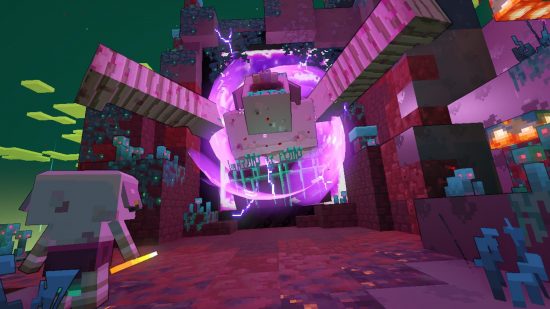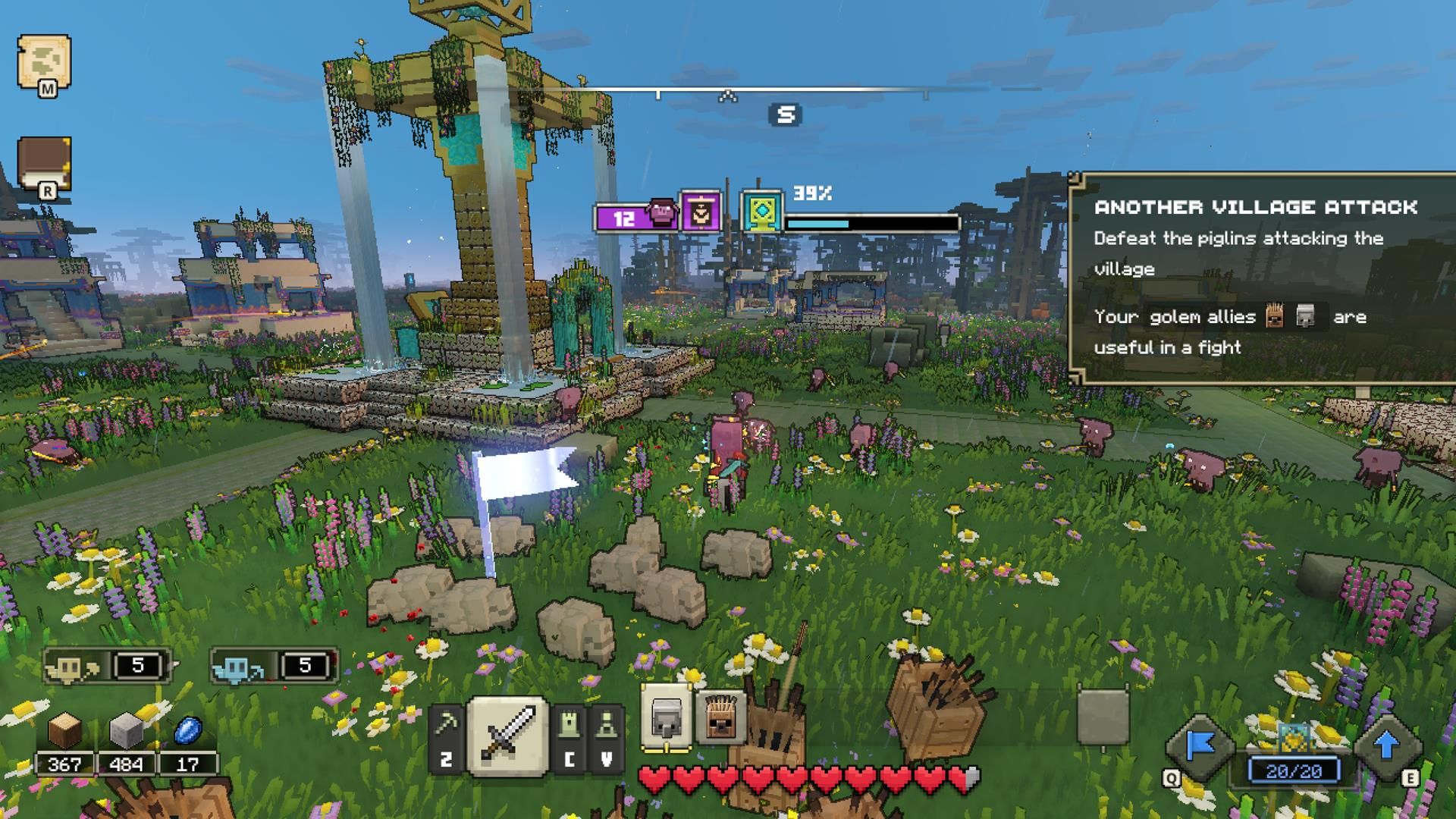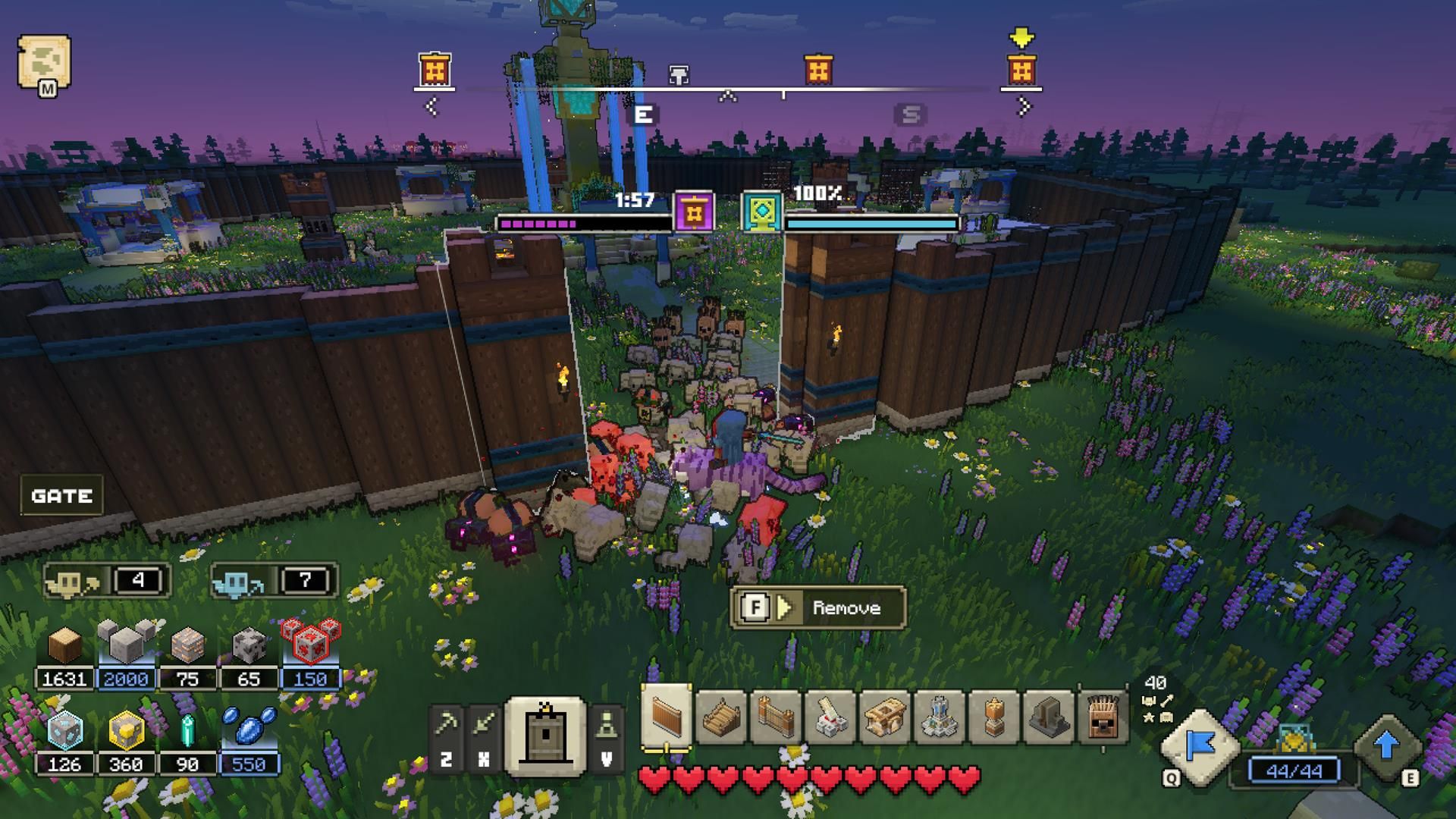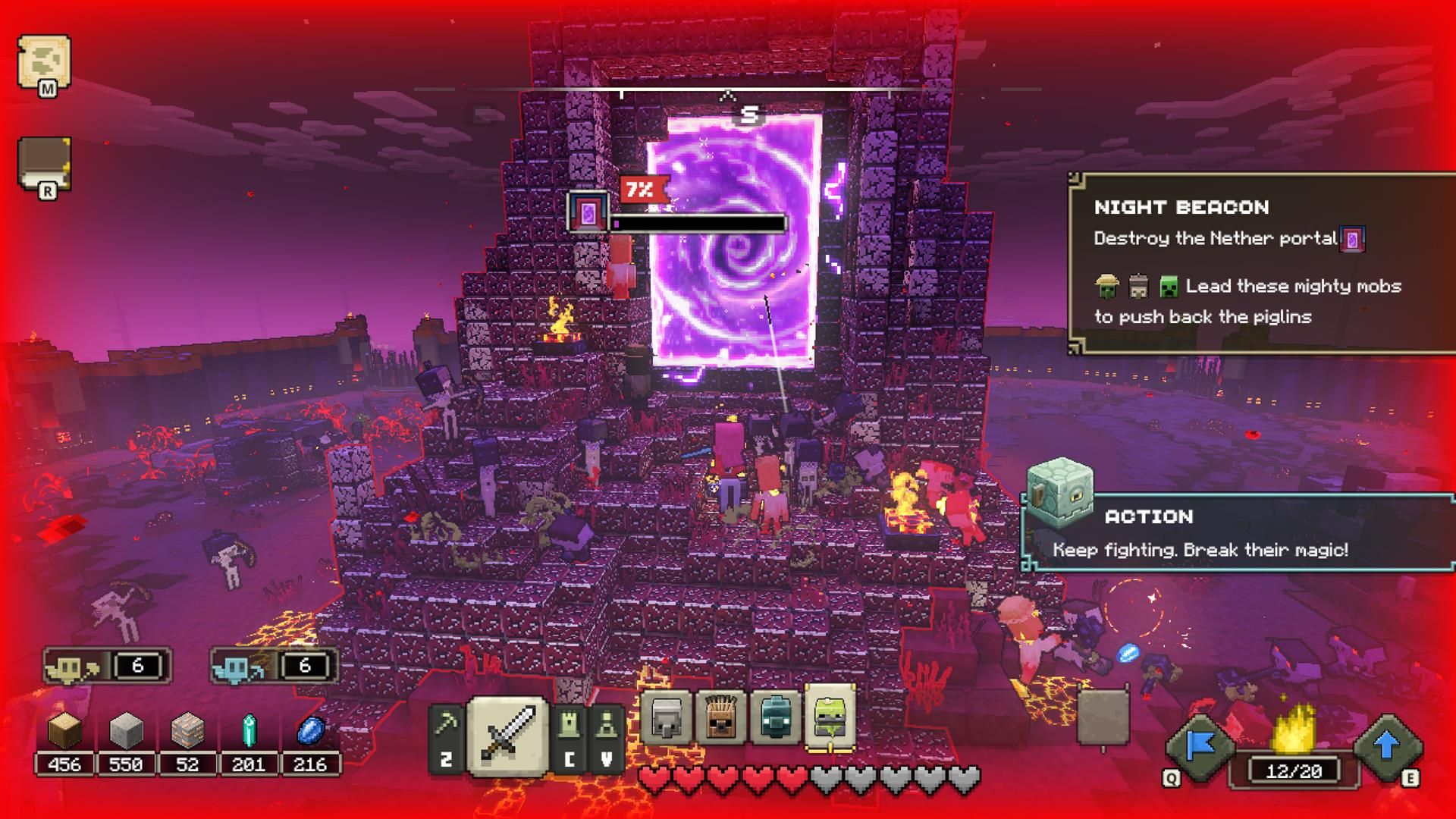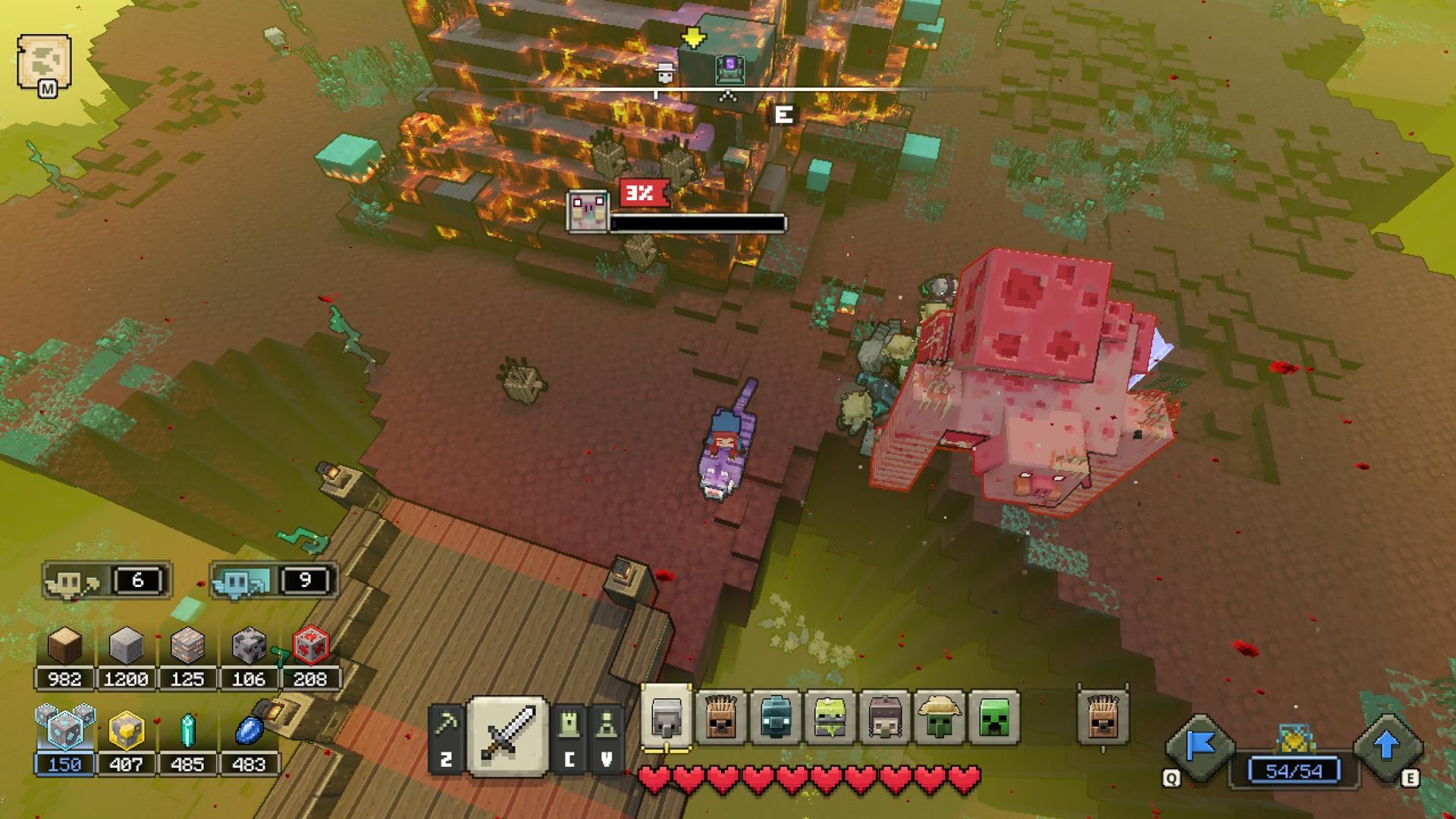Our Verdict
It isn't complex enough to satiate veteran RTS players and doesn't offer mountains of content, but Minecraft Legends delivers the basic loop of attacking and defending territory and finds the odd inventive way to use its iconic IP.
Until our Minecraft Legends review, I never expected Minecraft, of all franchises, to try and get in on the action-RTS subgenre. It’s hardly in vogue. But after manifesting both as an episodic narrative adventure (Minecraft Story Mode) and an ARPG (Minecraft Dungeons), Minecraft Legends does another solid job of extending the IP into new territory, even if its simplicity won’t do much to win over connoisseurs looking for either the ‘action’ or ‘RTS‘ components to really excel.
Like previous spinoffs, Minecraft Legends doesn’t attempt to play like its namesake at all. The story kicks off when your hero, whose appearance you choose from a small handful of options at the start, is tasked by a trio of otherworldly beings with saving a land from an invasion. The Piglins, Minecraft’s group of pig monsters from The Nether, are invading and there’s no one to stand in their way. It’s up to you to gather resources, take the fight to their bases, and smash their portals to smithereens.
Cutscenes routinely pop up with a bit of narration, but the pacing won’t randomly grind to a screeching halt for minutes of dialogue or attempts at characterisation. The narrative sequences are charming and display a lot of personality, even though the vast majority of the characters in them never speak. The game’s voxel presentation also looks as good as would be expected, although there are only quality presets to choose from with no advanced settings. Minecraft Legends looks just fine regardless, although it will absolutely benefit from some anti-aliasing via your GPU’s settings, as the game was quite jaggy for me at 1440p.
The player character in Minecraft Legends is permanently on horseback (or catback, if you choose to swap mounts) and can slash their sword if you hold or repeatedly press the attack button. There’s nothing more to your combat abilities than that, though. You don’t learn additional techniques, enemies’ reaction to damage doesn’t make it feel particularly impactful, and bizarrely only mobs can damage structures, which I dislike. Jumping and sprinting are the extent of your mobility, too. The ‘action’ side of things feels a bit light.
Things are thankfully more interesting when it comes to the ‘RTS’ elements and other systems. You spawn individual mobs by building small devices to summon them. You can only call forth one at a time, so you need to hold the button down while the others show up, which can get more than a bit monotonous when you’re summoning a few dozen at once. A press of a button calls any soldiers within its radius to follow you, but you can’t call them all to you at once.
As for commanding them, you can send them to rush forward within the standard third-person gameplay, or you can enter Banner Mode, which grants you an overhead view. This allows you to tell your mobs to either head to a point or focus on it, which sees them attacking a foe or building at that location. You can choose for all of your mobs to converge upon this point at once or break them up based on their designations, such as the aforementioned melee and ranged fighters, although you can’t send them forward based on their specific class.
There are seven types of Minecraft Legends mobs that vary from melee to ranged and support. The game starts you out with just two golem types that fall quickly to foes, but you’ll soon gain access to a couple of more specialised varieties as well as skeletons, zombies, and creepers. The skeletons and zombies completely outclass the starting ranged and melee golems, but they also require more uncommon resources. Resources are acquired in two ways, the first of which is the more hands-on; you’ll enter a mining mode and send creatures called allays to mine an area for specific resources. These creatures also construct your buildings, including the ones that spawn mobs. This will raise a smile if you’ve played ‘proper’ Minecraft; as Will found in his hands-on preview from GDC, it’s fun to command allays to build structures that you may have put together yourself with much more effort in the main game. If you’ve put in the hours at the personal perspective, scaling up is a particular thrill.
Upon starting the game, Minecraft Legends generates a world based on the difficulty you’ve selected; harder difficulties have larger maps and more major enemy bases. The worlds are decently large and open, containing a mixture of enemy bases, villages, friendly monster settlements, and points of interest, which allow you to summon giant golems or collect special towers that can be placed on the battlefield, provided you have the resources. You can fast travel between villages, all of which have chests that will grant certain resources indicated on the game’s map. These always include copious amounts of wood and stone, as well as lapis, which is needed to spawn mobs.
General gameplay divides into offensive and defensive action. Night-time is when you must defend; Piglins will typically invade a village or settlement at night, and supposedly you want to protect those, even if in my experience it wasn’t a huge deal if their central building gets totaled.
Attacking Piglin bases is clearly where the meat of the game lies. Each world has three factions of Piglin, and upon destroying all bases belonging to a faction, you’ll summon a boss. Destroy all three factions and all three bosses to summon a final boss and rid the world of the Piglin scourge – your ultimate goal.
One faction’s bases are often on cliffs, while another’s may be bolstered by layers of walls and iron gates. These outposts have different buildings that spawn enemies, shoot you from afar, or turn the ground into Netherrock, which you can’t build upon. You’ll want to use your mobs or buildings to destroy these, finally smash the Piglin Nether Portal, and remove all traces of them from the area. There are complications, of course.
The biggest problem I have with Minecraft Legends is simply that your mobs aren’t quite up to the task of following you. Reaching the cliffs that some bases sit on requires you to build ramps. This is awkward, even with a mouse, as it’s overly sensitive by default. Even worse, mobs consistently fail to walk across these ramps without falling. Some bases are surrounded by moats of lava that you’ll need to build ramps across and, yes, your mobs will fall in. The cliffs are worse, however. I regularly saw my mobs fall to the ground not only when trying to cross ramps, but when attacking enemies and buildings too close to edges.
Thankfully, you can recall all summoned mobs at any spawn building. I tended to build one of these at the highest level of the aforementioned elevated bases, as I’d always be down dozens of soldiers by the time I made it to the top. It doesn’t help that, when following you, your mobs aren’t always paying enough attention to actually attack anything they haven’t been specifically told to. The RTS mechanics in Minecraft Legends are functional, but the focus was clearly on console players feeling comfortable, so the lack of precision in your controls can be irksome.
Despite how carefully the game’s tutorial holds your hand, I was surprised by how little attempt there was to explain some important details. Enemy bases are all built upon tainted ground that you can’t build upon. To do so, you’ll need to destroy Netherrock generators, then use a machine that cleanses the area that needs to be purchased with an upgrade, but you’ll need to actually read all of the upgrade details to know that. Upgrades are all acquired by placing buildings at certain points on the Well that functions as the player’s central base, and you will run out of space to build them all by the end of the game. The game also does a less than ideal job of explaining the ways to get the main resource you need to acquire these upgrades.
Once the tainted ground is cleaned, you can place buildings. Regular towers and all wooden buildings can be upgraded to stone by using a mason, and you can even build a cannon of sorts to take potshots at enemy buildings, which can be invaluable. You’ll need to use these buildings to properly defend villages and settlements that are under attack. It gets fairly old having to stop what you’re doing every night to go fight the invaders, especially as the later-game enemy raids can last for eight minutes. This does at least change up the gameplay, however, and lower difficulties are quite lenient – you can often muddle through without building things and just point your mobs at the enemy.

Overall, I had a decent time with the Minecraft Legends campaign. It will likely take from ten to twenty hours depending on the difficulty selected (and even younger kids will be able to get through the lowest, which the game’s regenerating health system makes even easier), plus there’s a PvP mode in which players attempt to destroy each other’s bases. This has a notably different pace compared to the main campaign and adds a fair bit of longevity.
Once you beat the game, there will be no more enemies on that file, so you’ll need to begin anew. The action combat is mostly uninteresting and the RTS elements aren’t as in-depth as I would have liked (and getting all nearby mobs to follow you after sending them out is a pain), but the game is enjoyable enough that a broad swath of players will probably find something to like. As long as they’re not walking their mobs across bridges.
Interested? The Minecraft Legends release date is April 18, and it will be on Game Pass on release. Check out the Minecraft Legends system requirements to be sure your rig can run it, and here’s what we know about its Steam Deck compatibility so far. If you want more than the single-player campaign, then take a look at what to expect from Minecraft Legends multiplayer, and recruit some friends for battle.
